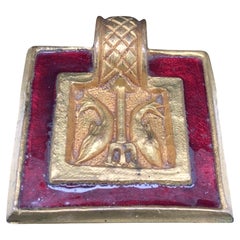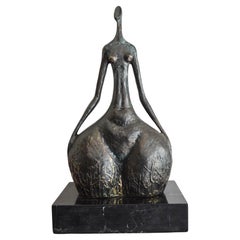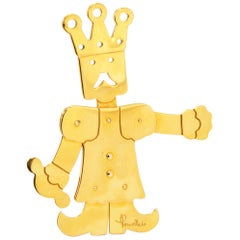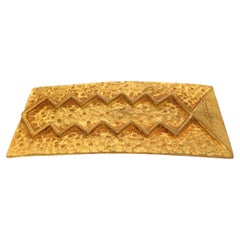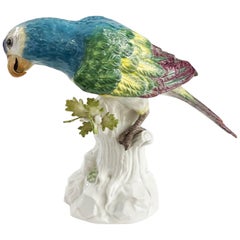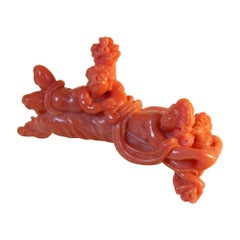European Figurines and Sculptures
to
40
83
54
30
28
27
18
12
9
8
8
7
40
118
35
3
1
4
3
2
2
3
21
14
4
5
183
17
1
11
10
7
7
4
11
11
6
5
5
24
14
12
12
11
10
2
2
1
1
1
1
198
3
96
93
Place of Origin: European
Gilt-bronze and red resin Pisces pendant by Line Vautrin
By Line Vautrin
Located in Idar-Oberstein, DE
Beautiful, bronze-doré and red 'Talesol' Pisces pendant by Line Vautrin, 1970s, marked Line Vautrin.
Line Vautrin (1913-1997) was a highly independent, self-taught, experimental art...
Category
1970s Modernist Vintage European Figurines and Sculptures
Materials
Bronze, Gilt Metal
Bronze Modernist Figure by Miguel Fernando Lopez Milo
Located in London, GB
Bronze Modernist Miguel Figure by Fernando Lopez Milo
A semi -abstract sculpture of Venus by Portuguese artist Miguel Fernando
Lopez on marble base.
Late 20th century. Floral designs on bronze
In excellent condition.
Signed MILO. Stamped with foundry mark in a circular plaque marked BRONZE GARANTI PARIS...
Category
Late 19th Century Artist Antique European Figurines and Sculptures
Materials
Bronze
Object d’Art Brass Pomellato King
By Pomellato
Located in Bilbao, ES
A window display Pomellato King
Original and authentical a 13mm Brass King from Pomellato merchandising and window display actually 4 in stock
Established 43 years ago in the Italian city of Milan, Pomellato has been forging its own meticulous path in jewelry making for many years. Having started life as a chain maker, the distinctive chain design still appears in every collection, albeit in ever more luxurious and bejeweled forms. From the iconic Nudo collection and its almost infinite combination of stackable rings to the colorful Capri collection, Pomellato jewelry...
Category
20th Century Contemporary European Figurines and Sculptures
Materials
Brass
$564 / item
Rare bronze-doré belt buckle by Line Vautrin
By Line Vautrin
Located in Idar-Oberstein, DE
Elegant and rare 1950s bronze-doré belt buckle by Line Vautrin,
with a raised geometric pattern and textured background,
marked Line Vautrin, with additional, original loop for th...
Category
Mid-20th Century Modernist European Figurines and Sculptures
Materials
Bronze, Gilt Metal
Hand Painted Multicolored Porcelain Parrot, Meissen Manufactory
Located in Roma, IT
This beautiful parrot was made by the Meissen factory, perhaps the oldest and most prestigious porcelain factory in Europe, using the model created by Kandler in the 1700s.
In 1731 t...
Category
2010s European Figurines and Sculptures
Coral Sculpture of Venus or Flora
Located in Amsterdam, NL
A coral sculpture of Venus with two putti: one in her arms, the other in her lap, and holding a cornucopia. Sciacca, Italy, 17th century.
Additiona...
Category
17th Century Antique European Figurines and Sculptures
Materials
Coral
1950s Lizard Diamond Yellow Gold 18 Karat Brooch Clip
Located in Geneva, CH
The Animal Lizard brooch clip in yellow gold 18k is a captivating piece of jewelry.
This brooch features a lizard design, crafted with meticulous attention to detail.
The lizard’s eyes are adorned with rose cut diamonds, adding a touch of sparkle and elegance. The head of the lizard is crowned by a beautiful pink sapphire, enhancing its regal appearance. This brooch is estimated to be from the 1950s and bears French assay marks, indicating its authenticity and quality. With its unique design and exquisite gemstone accents, this lizard brooch is a timeless and sophisticated accessory.
Total length: 2.56 inches (6.50 centimeters).
Total weight: 10.66 grams.
We are reknown for curating unfindable jewels.
Most of the pieces of our collection are antique, one-of-a-kind and formerly owned by...
Category
1950s Artist Vintage European Figurines and Sculptures
Materials
Pink Sapphire, Diamond, Gold, Yellow Gold
Dog Sculpture Poodle in Silver
By Lazzerini Argenteria
Located in Milano, Lombardia
Dog sculpture poodle in silver
Category
1980s Early Victorian Vintage European Figurines and Sculptures
Materials
Silver
Coral Angel Brooch
Located in Amsterdam, NL
A large coral brooch of an angel, Italy, 18th century.
weight: 19.1 grams
dimensions: 6.1 cm.
Category
Early 19th Century Georgian Antique European Figurines and Sculptures
Materials
Coral, 18k Gold
$7,132
19th Century Albert-Ernest Carrier-Belleuse Bronze Sculpture of Seated Virgil
By Albert-Ernest Carrier-Belleuse
Located in Hicksville, NY
French Second-Empire artist Albert Ernest Carrier-Belleuse is known as the most prolific sculptor of this period. His sculptures were displayed in the Tuileries, the Louvre and the O...
Category
Late 19th Century Napoleon III Antique European Figurines and Sculptures
Materials
Bronze
Late XIXc Swiss Black Forest Carved Walnut Bear Side Table with Tobacco Jar
Located in MELBOURNE, AU
Highly collectable,
this Black Forest Tobacco Jar Side table
is meticulously carved from walnut
in a form of a bear climbing a finely deta...
Category
1890s Victorian Antique European Figurines and Sculptures
Rare Porcelain Figure of 'Salome' by Karl Klaus for Ernst Wahliss
Located in Brisbane City, QLD
A very rare and important figure of 'Salome' holding the head of John The Baptist crafted in Austria. The figure is the work of Karl Klaus (1889-1925) and was crafted by the maker Ernst Wahliss around 1911. The figure depicts Salome, daughter of Herod II and Heordius, standing tall whilst reclining her neck, holding in her hands the severed head of John the Baptist. Richly decorated in a restrained palette of black, white, indigo blue, red and gold the figure is undeniably decorated in the Secessionist taste. Klaus was a student of Josef Hofmann and designed several figures and decorative pieces for Ernst Wahliss under the label 'Serapis Wahliss...
Category
Early 20th Century Art Nouveau European Figurines and Sculptures
Sterling Silver Stirrup Cup Wine Glasses 'Vermeil Inside' Depicting a Dog
Located in Roma, IT
This dog is one of 12 sterling silver "stirrup" glasses, vermeil inside, whose models date back to around the mid-1900s, and represent 12 animals that can be placed at the table to serve wine.
Most popular in the late 18th and 19th century, antique silver stirrup cups...
Category
1940s Vintage European Figurines and Sculptures
Materials
Vermeil, Sterling Silver
Male Doberman Dog Sculpture in Silver
By Lazzerini Argenteria
Located in Milano, Lombardia
Male Doberman dog sculpture in Silver
Category
1980s Early Victorian Vintage European Figurines and Sculptures
Materials
Silver
Sculpture of Dog Cocker in Silver
By Lazzerini Argenteria
Located in Milano, Lombardia
Sculpture of dog Cocker in silver
Category
1880s Early Victorian Antique European Figurines and Sculptures
Materials
Silver
Authentic Roman Marble 'Serpentino' Sterling Silver Place-Holder Obelisk
Located in Roma, IT
This obelisk in "Lapis lacedaemonius", called in ancient Rome "Serpentino", was made by our talented artisans: the one who cut the precious ancient marble and the one who made the st...
Category
2010s Classical Roman European Figurines and Sculptures
Materials
Sterling Silver
Silver Hound Bracco handicraft
By Lazzerini Argenteria
Located in Milano, Lombardia
Silver hound bracco handicraft
Category
1980s Early Victorian Vintage European Figurines and Sculptures
Materials
Silver
18 kt yellow gold with orange big heart pendant, diamonds 0.60 ct.
Located in BARI, IT
Spectacular natural coral pendant in the shape of a big heart. It has been hand-engraved on both sides and mounted in yellow gold 18 kt. with diamonds, brilliant cut, 0.60 ct. The go...
Category
1980s Vintage European Figurines and Sculptures
Materials
Coral, Diamond, Yellow Gold
Natural Coral Starfish Pendant Necklace 18 Kt White Gold Diamonds 0.40 Ct
Located in BARI, IT
Natural coral pendant in the shape of a starfish, mounted in 18 kt white gold with 0.40 ct diamonds, brilliant cut. Its total weight is 41.8 g. The counter mesh also has some diamond...
Category
1990s European Figurines and Sculptures
Materials
Coral, Diamond, White Gold
$8,184 Sale Price
34% Off
Rosior Pair of "Laughing Boys" in Sterling Silver and Wood
By Rosior
Located in Porto, PT
A pair of "laughing boy and girl" manufactured in Sterling Silver, each figure depicted seated and each holding a different silver "basket". Hands manufac...
Category
21st Century and Contemporary Contemporary European Figurines and Sculptures
Materials
Silver, Sterling Silver
Pineapple Handicraft in Silver
By Lazzerini Argenteria
Located in Milano, Lombardia
Pineapple handicraft in silver
Category
1980s Early Victorian Vintage European Figurines and Sculptures
Materials
Silver
Recently Viewed
View AllMore Ways To Browse
Cameo Stick Pin
Cento Diamond
Chanel Brooch Diamond
Chanel Gripoix 1969
Chanel Vintage Turn Lock
Chaumet Ruby
Chinese Enamel Brooch
Chopard Blue Sapphire
Christian Dior Perfume
Christian Dior Swarovski
Ciro Jewelry Vintage
Ciro Jewelry
Coral Cameo And 14k
Coral Monkey
Coro Bird
Crane Brooch
Cross Scotland
Crystal Opal And Diamond Brooches
